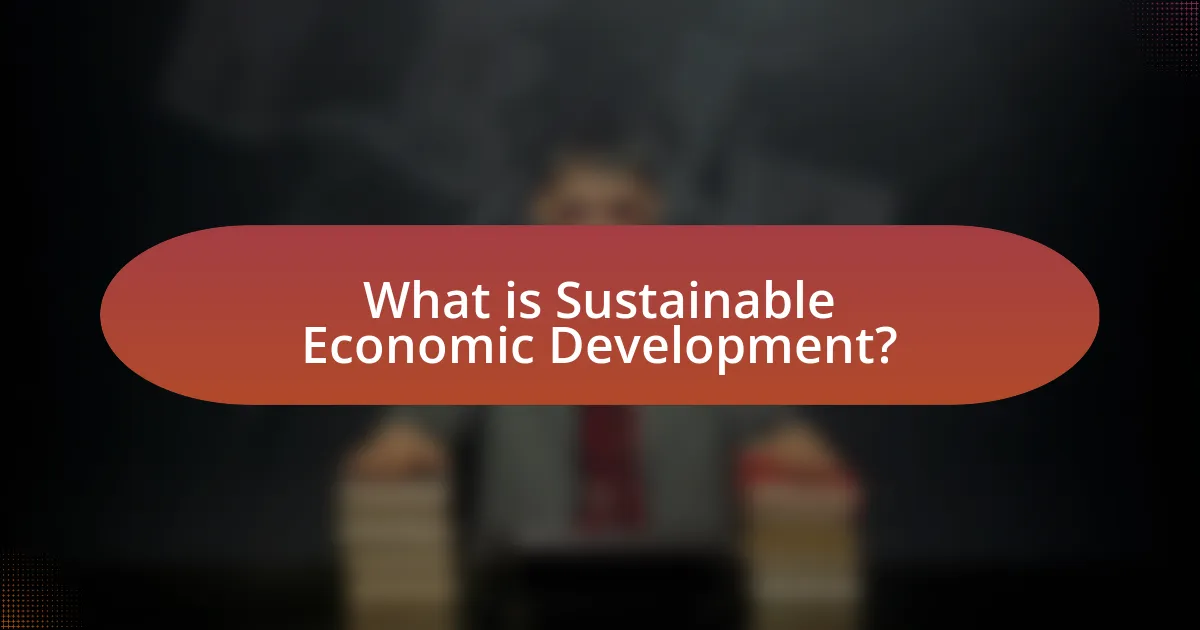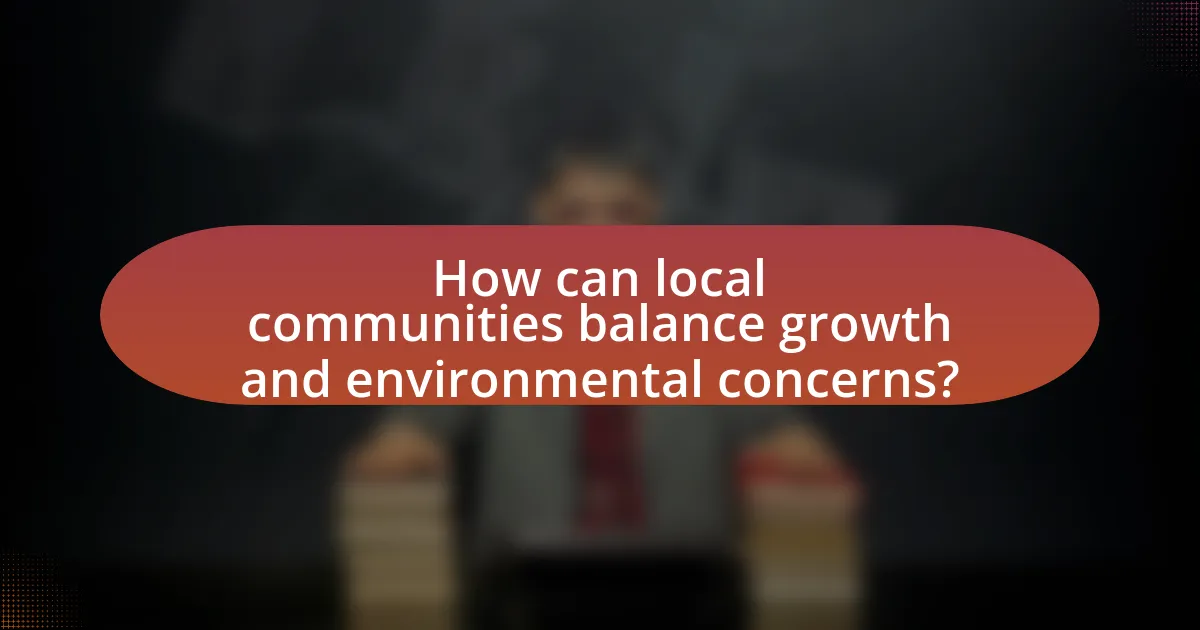Sustainable economic development is an approach that seeks to harmonize economic growth with environmental sustainability and social equity, ensuring that current needs do not compromise future generations. This article explores the distinctions between sustainable and traditional economic development, emphasizing the importance of integrating environmental concerns into economic practices. Key principles such as environmental sustainability, social equity, and economic viability are discussed, along with the role of community engagement and policy initiatives in achieving sustainable goals. Additionally, the article addresses the challenges local communities face in implementing sustainable practices and highlights successful strategies and partnerships that promote sustainable economic development.

What is Sustainable Economic Development?
Sustainable economic development is an approach to economic growth that seeks to balance the needs of the economy with environmental sustainability and social equity. This concept emphasizes the importance of meeting present economic demands without compromising the ability of future generations to meet their own needs. According to the Brundtland Commission’s 1987 report, “Our Common Future,” sustainable development integrates economic, social, and environmental objectives, ensuring that growth does not deplete natural resources or harm ecosystems. This framework is essential for fostering resilient local communities that can thrive economically while preserving their environmental and social fabric.
How does Sustainable Economic Development differ from traditional economic development?
Sustainable Economic Development focuses on long-term ecological balance and social equity, while traditional economic development primarily emphasizes short-term economic growth and profit maximization. Sustainable Economic Development integrates environmental stewardship and community well-being into its framework, aiming to meet present needs without compromising future generations’ ability to meet theirs. In contrast, traditional economic development often prioritizes industrial expansion and resource extraction, frequently leading to environmental degradation and social inequality. For example, the United Nations’ Sustainable Development Goals highlight the importance of sustainability in economic practices, underscoring the need for a holistic approach that traditional methods often overlook.
What are the key principles of Sustainable Economic Development?
The key principles of Sustainable Economic Development include environmental sustainability, social equity, and economic viability. Environmental sustainability ensures that natural resources are used responsibly and preserved for future generations, as highlighted by the United Nations’ Sustainable Development Goals, which emphasize the need for sustainable management of resources. Social equity focuses on providing fair access to economic opportunities and benefits for all community members, addressing disparities and promoting inclusivity. Economic viability involves creating a stable and resilient economy that can support long-term growth while minimizing negative impacts on the environment and society. These principles collectively aim to balance economic growth with environmental protection and social well-being, fostering a holistic approach to development.
Why is it important to integrate environmental concerns into economic growth?
Integrating environmental concerns into economic growth is crucial to ensure sustainable development and prevent ecological degradation. Economic activities often lead to resource depletion and environmental harm, which can undermine long-term growth prospects. For instance, the World Bank reports that environmental degradation can cost countries up to 8% of their GDP annually due to lost ecosystem services and increased health care costs. By incorporating environmental considerations, economies can promote resilience, enhance resource efficiency, and foster innovation in sustainable technologies, ultimately leading to a more balanced and sustainable growth trajectory.
What are the main goals of Sustainable Economic Development?
The main goals of Sustainable Economic Development are to promote economic growth while ensuring environmental protection and social equity. This approach aims to create a balanced framework where economic activities do not compromise ecological integrity or the well-being of communities. For instance, the United Nations’ Sustainable Development Goals (SDGs) emphasize the importance of sustainable practices that foster economic resilience, reduce inequalities, and protect natural resources, highlighting that sustainable economic development is essential for long-term prosperity and environmental sustainability.
How does Sustainable Economic Development aim to reduce poverty?
Sustainable Economic Development aims to reduce poverty by promoting inclusive economic growth that creates job opportunities and enhances access to essential services. This approach focuses on integrating environmental sustainability with economic policies, ensuring that growth benefits all community members, particularly marginalized groups. For instance, initiatives such as microfinance programs and vocational training can empower individuals, leading to increased income and improved living standards. According to the United Nations Development Programme, sustainable practices can lead to a 30% increase in income for the poorest households, demonstrating the effectiveness of this strategy in alleviating poverty.
What role does community engagement play in achieving these goals?
Community engagement is essential for achieving sustainable economic development goals as it fosters collaboration between stakeholders, ensuring that local needs and environmental concerns are addressed. Engaged communities contribute valuable insights and resources, leading to more effective decision-making and implementation of sustainable practices. For instance, studies show that projects with strong community involvement are 30% more likely to succeed, as they align with the community’s values and priorities, thereby enhancing both economic growth and environmental stewardship.

What challenges do local communities face in implementing Sustainable Economic Development?
Local communities face several challenges in implementing Sustainable Economic Development, including limited financial resources, lack of technical expertise, and insufficient stakeholder engagement. Limited financial resources hinder the ability to invest in sustainable projects, as many communities operate on tight budgets and struggle to secure funding. Additionally, a lack of technical expertise can impede the development and execution of sustainable initiatives, as community members may not possess the necessary skills or knowledge to implement effective strategies. Furthermore, insufficient stakeholder engagement can lead to resistance or apathy among community members, making it difficult to achieve consensus and mobilize collective action for sustainable development efforts. These challenges collectively undermine the potential for local communities to successfully balance economic growth with environmental sustainability.
How do economic pressures impact environmental sustainability?
Economic pressures significantly undermine environmental sustainability by prioritizing short-term financial gains over long-term ecological health. For instance, industries facing economic downturns may exploit natural resources unsustainably to cut costs, leading to deforestation, pollution, and biodiversity loss. A study by the World Bank indicates that countries with high economic stress often experience increased environmental degradation, as seen in regions where rapid industrialization occurs without adequate regulatory frameworks. This correlation highlights that economic imperatives can drive decisions that compromise environmental integrity, ultimately threatening the sustainability of local ecosystems and communities.
What are the common conflicts between economic growth and environmental protection?
Common conflicts between economic growth and environmental protection include resource depletion, pollution, and habitat destruction. Economic growth often relies on the extraction and consumption of natural resources, leading to depletion of these resources and long-term environmental degradation. For instance, industrial activities can result in air and water pollution, adversely affecting ecosystems and human health. Additionally, urban expansion and infrastructure development can lead to habitat destruction, threatening biodiversity. According to the World Bank, unsustainable practices can undermine the very economic foundations they aim to support, highlighting the need for a balance between growth and environmental stewardship.
How can local communities address these conflicts effectively?
Local communities can address conflicts effectively by fostering inclusive dialogue among stakeholders, which ensures that diverse perspectives are considered in decision-making processes. This approach promotes collaboration between local governments, businesses, and residents, leading to more equitable solutions that balance economic growth with environmental sustainability. Evidence from community-led initiatives, such as the Sustainable Communities Program, demonstrates that engaging all parties in discussions reduces tensions and enhances trust, ultimately resulting in more sustainable development outcomes.
What role do policies play in Sustainable Economic Development?
Policies are essential in guiding Sustainable Economic Development by establishing frameworks that promote environmental protection while facilitating economic growth. These policies create regulations and incentives that encourage businesses to adopt sustainable practices, such as reducing carbon emissions and conserving resources. For instance, the implementation of carbon pricing mechanisms has been shown to reduce greenhouse gas emissions while stimulating innovation in clean technologies. Furthermore, policies that support renewable energy investments can lead to job creation and economic diversification, as evidenced by the growth of the solar and wind energy sectors in various countries. Thus, effective policies are crucial for aligning economic objectives with environmental sustainability, ensuring long-term viability for local communities.
How can local governments create supportive policies for sustainable practices?
Local governments can create supportive policies for sustainable practices by implementing regulations that promote renewable energy, incentivizing green building standards, and fostering community engagement in sustainability initiatives. For instance, cities like San Diego have adopted policies that require new buildings to meet energy efficiency standards, which has led to a significant reduction in greenhouse gas emissions. Additionally, local governments can offer tax credits or grants for businesses that adopt sustainable practices, as seen in Portland, Oregon, where such incentives have encouraged local businesses to invest in eco-friendly technologies. Engaging the community through public forums and workshops can also help identify local sustainability needs and priorities, ensuring that policies are tailored to the specific context of the community.
What are examples of successful policy initiatives in local communities?
Successful policy initiatives in local communities include the implementation of community solar programs, which allow residents to invest in and benefit from renewable energy sources. For instance, the city of San Diego launched a community solar program that has increased access to clean energy for low-income households, resulting in a 20% reduction in energy costs for participants. Another example is the establishment of urban agriculture policies, such as those in Detroit, which have transformed vacant lots into productive gardens, improving food security and community engagement. These initiatives demonstrate effective strategies for promoting sustainable economic development while addressing environmental concerns.

How can local communities balance growth and environmental concerns?
Local communities can balance growth and environmental concerns by implementing sustainable development practices that prioritize ecological integrity alongside economic expansion. This involves adopting policies that promote green infrastructure, such as renewable energy sources and efficient waste management systems, which can reduce environmental impact while supporting local economies. For instance, a study by the World Resources Institute found that cities investing in green spaces and sustainable transport can enhance both quality of life and economic resilience. Additionally, engaging community stakeholders in decision-making processes ensures that growth initiatives align with environmental preservation, fostering a sense of ownership and responsibility towards local ecosystems.
What strategies can be employed to promote sustainable practices?
To promote sustainable practices, communities can implement strategies such as adopting renewable energy sources, enhancing waste management systems, and encouraging sustainable agriculture. For instance, transitioning to solar or wind energy reduces reliance on fossil fuels, which is crucial for lowering greenhouse gas emissions. According to the International Renewable Energy Agency, renewable energy could account for 86% of global power demand by 2050, demonstrating its potential impact. Additionally, improving waste management through recycling and composting can significantly reduce landfill waste, as evidenced by a study from the Environmental Protection Agency, which found that recycling and composting prevented the release of 186 million metric tons of carbon dioxide equivalent into the air in 2013. Lastly, promoting sustainable agriculture practices, such as organic farming and crop rotation, can enhance soil health and biodiversity, contributing to long-term food security and environmental sustainability.
How can local businesses contribute to Sustainable Economic Development?
Local businesses can contribute to Sustainable Economic Development by promoting environmentally friendly practices and supporting the local economy. By implementing sustainable practices such as reducing waste, utilizing renewable energy sources, and sourcing materials locally, these businesses minimize their environmental impact. For instance, a study by the American Sustainable Business Council found that local businesses that adopt sustainable practices can reduce operational costs by up to 30%, demonstrating that sustainability can also lead to economic benefits. Additionally, local businesses create jobs and keep money circulating within the community, which strengthens the local economy and fosters resilience against economic downturns.
What are the benefits of adopting green technologies in local economies?
Adopting green technologies in local economies leads to enhanced sustainability, economic growth, and improved public health. Green technologies, such as renewable energy systems and energy-efficient practices, reduce reliance on fossil fuels, which lowers greenhouse gas emissions and mitigates climate change impacts. For instance, a study by the International Renewable Energy Agency found that transitioning to renewable energy could create up to 24 million jobs globally by 2030, benefiting local economies through job creation and increased investment. Additionally, green technologies often lead to cost savings for businesses and consumers through reduced energy bills, further stimulating local economic activity. Furthermore, improved air and water quality resulting from the adoption of these technologies contributes to better public health outcomes, reducing healthcare costs and enhancing the quality of life for residents.
What role does education play in fostering Sustainable Economic Development?
Education plays a crucial role in fostering Sustainable Economic Development by equipping individuals with the knowledge and skills necessary to engage in environmentally responsible practices and innovative economic activities. Through education, individuals learn about sustainable practices, resource management, and the importance of balancing economic growth with environmental stewardship. For instance, a study by the United Nations Educational, Scientific and Cultural Organization (UNESCO) highlights that education for sustainable development can lead to increased awareness and action towards sustainability, ultimately contributing to economic resilience and community well-being. This connection between education and sustainable economic practices is further supported by evidence showing that educated populations are more likely to adopt green technologies and sustainable business models, thereby enhancing local economies while protecting the environment.
How can educational programs raise awareness about sustainability?
Educational programs can raise awareness about sustainability by integrating sustainability concepts into curricula and promoting hands-on experiences. For instance, programs that include project-based learning, such as community gardens or recycling initiatives, engage students directly with sustainable practices. Research indicates that experiential learning increases retention of sustainability concepts, as demonstrated in a study by the National Environmental Education Foundation, which found that students involved in hands-on environmental projects showed a 70% increase in knowledge retention compared to traditional learning methods. By fostering critical thinking and problem-solving skills related to environmental issues, educational programs effectively cultivate a generation that values and prioritizes sustainability.
What partnerships can be formed between educational institutions and local communities?
Educational institutions can form partnerships with local communities through collaborative programs, resource sharing, and community engagement initiatives. These partnerships often include joint research projects that address local environmental concerns, internships for students in local businesses, and community service projects that benefit both students and residents. For instance, universities may collaborate with local governments to develop sustainable practices that enhance economic development while preserving the environment. Such partnerships have been shown to improve educational outcomes and foster community resilience, as evidenced by programs like the University of California’s Sustainable Agriculture Research and Education Program, which connects students with local farmers to promote sustainable practices.
What are best practices for local communities pursuing Sustainable Economic Development?
Local communities pursuing Sustainable Economic Development should prioritize stakeholder engagement, sustainable resource management, and the promotion of local businesses. Engaging stakeholders, including residents, businesses, and local governments, fosters collaboration and ensures that development initiatives reflect community needs and values. Sustainable resource management involves using resources efficiently and responsibly, which can be supported by implementing practices such as renewable energy adoption and waste reduction strategies. Promoting local businesses strengthens the local economy and reduces environmental impact by minimizing transportation emissions. According to the United Nations’ Sustainable Development Goals, these practices contribute to economic growth while ensuring environmental sustainability, demonstrating their effectiveness in achieving balanced development.
How can communities measure the success of their sustainable initiatives?
Communities can measure the success of their sustainable initiatives through specific metrics such as reductions in carbon emissions, increases in recycling rates, and improvements in local biodiversity. For instance, a community may track its carbon footprint before and after implementing a renewable energy program, finding a reduction of 20% in emissions over five years. Additionally, surveys can assess community engagement and satisfaction with sustainability efforts, providing qualitative data to complement quantitative metrics. Research from the Global Reporting Initiative indicates that communities using standardized sustainability reporting frameworks can effectively benchmark their progress against global standards, enhancing accountability and transparency.
What resources are available for communities to support their sustainable efforts?
Communities can access various resources to support their sustainable efforts, including government grants, non-profit organizations, and educational programs. Government grants, such as those from the Environmental Protection Agency, provide funding for projects aimed at improving environmental quality and promoting sustainability. Non-profit organizations, like the Sierra Club and local conservation groups, offer resources, expertise, and sometimes financial assistance for community-led sustainability initiatives. Educational programs, often provided by universities or local governments, equip community members with knowledge and skills related to sustainable practices, such as energy efficiency and waste reduction. These resources collectively empower communities to implement effective sustainable development strategies.




